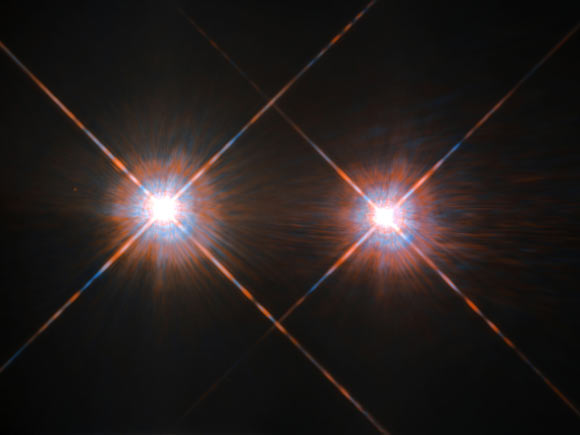New observations by NASA’s Chandra X-ray Observatory indicate the two brightest stars in the triple-star system Alpha Centauri are not pummeling any orbiting exoplanets with large amounts of X-rays.
Alpha Centauri, also known as Rigil Kentaurus, Rigil Kent and Gliese 559, is the closest stellar system to Earth.
This triple system is made up of the bright binary star formed by Alpha Centauri A and B, plus the faint star Alpha Centauri C.
The two brighter members are roughly 4.35 light-years away from us. Alpha Centauri C, better known as Proxima Centauri, is slightly closer, at 4.23 light-years.
Compared to the Sun, Alpha Centauri A is of the same stellar type G2, and slightly bigger (1.1 times more massive than the Sun and about 1.5 times more luminous). Alpha Centauri B, a K1-type star, is slightly smaller and less bright (0.9 times the mass of the Sun and about 45% of its visual luminosity).
Alpha Centauri A and B orbit a common center of gravity once every 80 years, with a minimum distance of about 11 times the distance between the Earth and the Sun.
Proxima is a much smaller red dwarf star that travels around the AB pair in a much larger orbit that takes it more than 10,000 times farther from the AB pair than the Earth-Sun distance.
“The Alpha Centauri system is seen by many as the best candidate to explore for signs of life,” said Dr. Tom Ayres, senior research associate in the Center for Astrophysics and Space Astronomy at the University of Colorado Boulder.
“The question is, will we find planets in an environment conducive to life as we know it?”

Chandra data from May 2, 2017 are seen in the pull-out, which is shown in context of a visible-light image taken from the ground of the Alpha Centauri system and its surroundings. Image credit: Zdenek Bardon / NASA / CXC / University of Colorado / T. Ayres.
To help determine whether Alpha Centauri stars are hospitable to life, astronomers have run a long-term campaign in which NASA’s Chandra X-ray Observatory has observed the system’s two main stars about every six months since 2005.
Chandra is the only X-ray observatory capable of resolving AB during its current close orbital approach, to determine which star is doing what.
These long-term measurements have captured the complete ups and downs of the X-ray activity of AB, analogous to the Sun’s 11-year sunspot cycle.
They show that any planets in the habitable zone for Alpha Centauri A would receive a lower dose of X-rays, on average, than similar planets around the Sun.
For companion B the X-ray dose for habitable zone planets is higher than for the Sun, but only by a factor of about five.
Proxima, on the other hand, is a type of active red dwarf star known to frequently send out dangerous flares of X-ray radiation, and is likely hostile to life.
“This is very good news for the AB pair in terms of the ability of possible life on any of their planets to survive radiation bouts from the stars,” Dr. Ayres said.
“Chandra shows us that life should have a fighting chance on planets around either of these stars.”
Dr. Ayres presented his findings June 6, 2018 at the 232nd Meeting of the American Astronomical Society in Denver, Colorado.
Some of the results were published in January 2018 in the Research Notes of the American Astronomical Society.
Source: Sci News

































Leave a Comment
You must be logged in to post a comment.